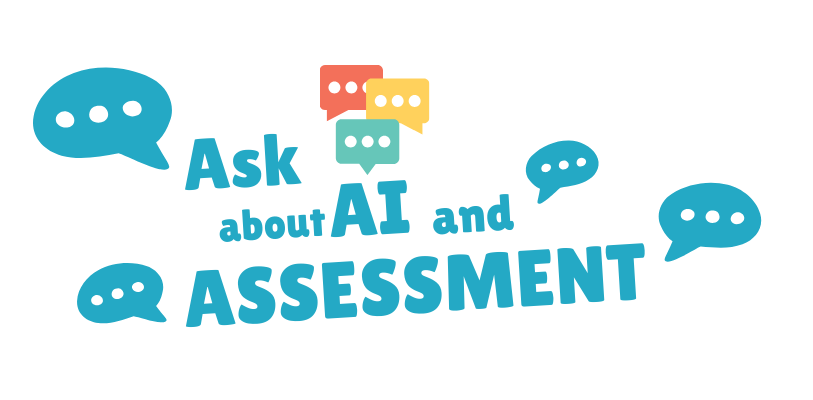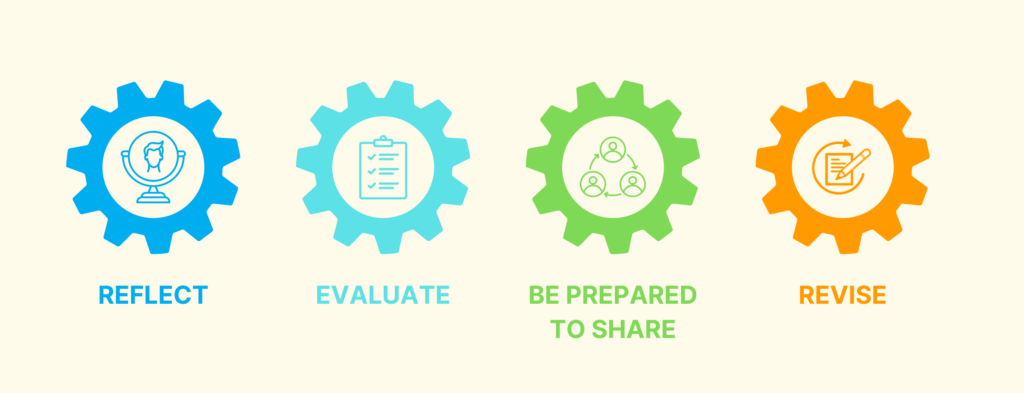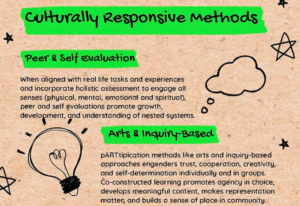AI and Assessment
- 4 mins read
Download an Alternate format
Have you ever been to those evening meetings for sessional faculty where everyone gathers in an empty classroom after business hours to talk the business of education. It’s the best of a tough situation. I admire the organizers for their patience, good will, and energy. If you find yourself in a faculty meeting where the energy is low and instructors are tired, overwhelmed, and running on empty to the best of their abilities, here’s a quick tip to get people energized. Your prep for this energizer is minimal but you will get outsized results.
Here’s what you need to do:

…and let the conversations begin.
That’s it. End of pep talk.
No slides, no speeches, no guest speakers or recordings from some expert across the country. Your prep work is done by the time you finish typing the words on the meeting agenda.

I guarantee you that within seconds, you will have the room buzzing, and grown adults will be putting up their hands to speak like the keenest of Grade 3ers. Every instructor, no matter how familiar they are with AI, ChatGPT, Claude, Gemini, etc. will have something to say. Sometimes the conversation will be measured, thoughtful and well informed, and yet often you may feel like the Martians are invading. It’s like everyone has had “an experience”. Over the past year, I have been part of discussion groups, we have invited speakers to JIBC to talk about AI, we have had our own little animated chats on the matter, thinking about how instructors can use AI, and of course, how students use it. I have yet to be in a session where we resolved the matter. It is the water cooler conversation of education at the moment.
And yet, the work continues. Instructors teach, students learn, courses have assignments. And AI is at the ready.
At this point, I believe the question is less of “What can I do?” but maybe more productively, “What can we do?” As educators with a responsibility to our students. I don’t think leaving instructors to figure things out on their own the best they can is the best practice, and I appreciate programs like Law Enforcement Studies where instructors are invited to weigh in on the matter and share approaches and ideas. That was my experience a few weeks ago. Out of that particularly animated discussion, I did learn a few important things about how to work with this amazing, fascinating, and wholly confounding new and highly disruptive technology.
Let’s consider things one can do.
What can you do at the start of the class?
New tech always helps to remind us about fundamental, time-proof good educational practices. One of them is that as an instructor you have to communicate your expectations to your students. There are a few ways to do this.
You can include something in your syllabus and share those expectations with students.
The advantage of this is having something concrete in writing that you can refer to. But don’t just leave your thoughts in the syllabus. Get them out there. Talk about them with students. You can even test them on it. For years, I used to have a quiz called Readiness to Learn. It was basically a review of my expectations in my class, including definitions of plagiarism and academic integrity. The test was worth 0 in the grand scheme of the class, but it was required, and everyone completed it.
In that syllabus you can include the following:
- Communicate your own approach to the craft of writing and how you learn, what works for you, what you recommend.
- Also talk about what you do not recommend. What are your limits and why have you set those limits?
- Explain clearly the consequences of choosing not to follow the stated expectations. That is, what are the consequences for late submissions, plagiarism detection, unauthorized help, inappropriate use of other technologies, etc.
Doing this right means you need to familiarize yourself with the policy on Academic Integrity. It is important to know what is permissible for students broadly and what constitutes unacceptable academic behaviour and when and how your institute will back you up.
You should be in communication with your program area and fellow instructors.
This is challenging for sessional who have other competing commitments like full-time careers! However, the more you know what’s going on, the better. And you can be certain that if you are struggling with this brave new world, you can bet that your colleagues are having similar experiences.
It is better for programs generally when faculty have some shared understanding about the technologies that you are recommending or what crosses a line in terms of getting help with assignments.
You can work with students to set expectations.
What is acceptable in your class? Try the following questions. Also, you need to remember what is feasible in terms of you authorizing or forbidding an action.
How do you rank the following in terms of acceptability.
It doesn’t actually matter how you answered these questions. The point is that it’s worth sharing your impressions with others who are sharing your challenges. The result of the discussion might point to a way forward and possibly some relief from the idea that your solution to academic integrity issues is a game of ed tech whack-a-mole.
What do you do during the class?
So that is just to get you thinking about how AI has totally jolted you out of your well-oiled routines. What to do next.
One thing you can do with a Syllabus is to transform it from a stale, unread artifact into a living, working document. You can do that by working with students to get agreement on acceptable practice and conduct in your classroom. This is time well spent and follows the maxim of “an ounce of prevention is worth a pound of cure.” It is also good practice to involve students in the setting of expectations of the class. They are more likely to commit to an agreement they have created with you rather than one imposed upon them from on high.
As we all get more familiar with these tools, it is almost guaranteed that they will find their way into our own writing practices as educators. So, we should be prepared to use them in productive ways that we would also expect of our students. It is tempting to find out what the tools are so that we can ban them, but that is already a game of whack-a-mole. AI writing apps abound, a quick search will reveal all the possibilities, so trying to keep track of them will not do one much good. Also, we have to remind ourselves that these apps are not designed for students, they are designed for anyone doing writing, but especially in the workplace, so those who write or teach writing should seek to be informed.
Mathematicians do use calculators without violating their ethical positions, those who write and teach writing should be able to understand, ethical and productive uses of writing technologies, such as chat GPT. One of these ways is to use the tool to interrogate passages of writing or to ask for further clarifications on an existing piece of literature. The uses of generative AI to help us learn our vast and many, and we are all still learning these as we go along. Those who depend on writing in their work, have a professional responsibility to understand these tools and in time, they will become embedded in our classrooms, so the time to learn more about them now.
What do you do when you discover the unauthorized use of AI in a class assignment?
Students looking for shortcuts or an edge in the pursuit of good grades are always going to be around at some percentage. It helps to work to create mitigating factors or to revise assessments in order to prevent the appeal of cheating as much as possible while maintaining the integrity of the learning experience. However, cheating still happens. So do mistakes.
Here is what you can do upon discovering some unwarranted use of forbidden AI tools in assessment work:
- That syllabus sure is handy. Referring back to it allows you to apply consistent penalties to students in the event of a case of academic misconduct. Also, knowing your academic integrity policy, which you would have referred to you in your syllabus, will help you know what your options are in terms of responsive actions.
- Along with this, it is expected that you will adhere to the agreements you’ve reached with your students. If there are grading consequences for discovered unauthorized use of tools, then follow through. This is fair for all students, including those who have not taken any shortcuts. They can be assured that their hard work will be assessed on its own merits
- Faculties where instructors have some understanding of what each other is doing are more likely to be able to apply consistent responses in the event of academic misconduct cases. This is why those who overcome their weariness to attend those evening faculty meetings are contributing to a strong, coherent program for their institute.
What do you do after you’ve finished teaching?
Finally, there is the question of what to do after your class has ended. Again, we’ve known what to do long before ChatGPT showed up. The answer is simple:

The underlying message is that departments and programs need to work on this together rather than leaving instructors to figure things out on their own. Unfortunately, sometimes we’re too busy rushing from the end of one class to the start of another, and so the first thing to drop off is any kind of evaluation. However, we have to ask ourselves what is the evaluation of our own assessments? What is important to us as educators? What are we striving for?
Further reading/listening
Bowen, J. (2024). Teaching with AI. Teaching in Higher Ed Podcast with Bonni Stachowiak.
Parks, M. and Oslick, M. (May 22, 2024). Empowering student learning: Navigating Artificial Intelligence in the college classroom. Faculty Focus.
Watson, E. (2024). Thinking with and about AI. Teaching in Higher Ed Podcast with Bonni Stachowiak
Young, J. (May 2024). Professors try ‘restrained AI’ approach to help teach writing. Ed Surge.








